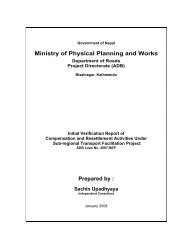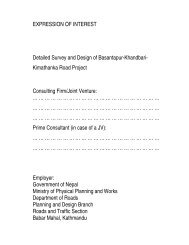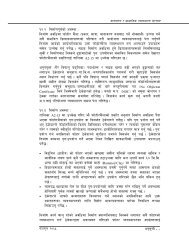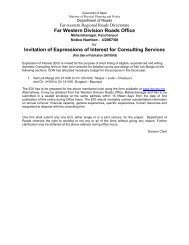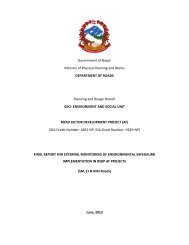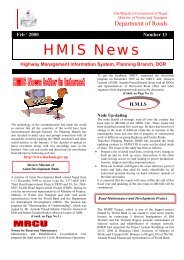Environmental & Social Management Framework - About ...
Environmental & Social Management Framework - About ...
Environmental & Social Management Framework - About ...
You also want an ePaper? Increase the reach of your titles
YUMPU automatically turns print PDFs into web optimized ePapers that Google loves.
<strong>Environmental</strong> and <strong>Social</strong> <strong>Management</strong> <strong>Framework</strong>n. Avoiding Hazards caused by the use of Bitumen• Mitigative Measures:- The contractors must use bitumen emulsion where feasible;- In hilly areas with steep road gradients, cut-back bitumen should be used;- Use of fuel wood for heating bitumen shall be discouraged;- Where heating is required, bitumen heaters should be used, fuelled byeither kerosene, diesel or gas;- Bitumen should not be applied during strong winds and rainy periods, or ifrain is likely;- No bituminous materials should be discharged into side drains;- Nearby trees, vegetation and private property should be protected (withcloth, plastic sheets, straw) during bitumen spraying work;- Bitumen drums should be stored at designated locations and notscattered along the road.- Work personnel handling hot bitumen must wear all time protective cloths(appropriate shoes, gloves). Work time with bitumen should be confinedto maximum 4 consecutive hrs/day to prevent respiratory hazards.(2) Impact Mitigation relating to the Biological Environmenta. Clearing of Forest Land and Habitat Damage or LossRoad development projects have manifold direct ad indirect (induced) impactsaffecting the ecological conditions in the zone of influence at various time andspace extent. This holds particularly true for aquatic systems where projectinducedimpacts are often noticed at much further distance and time lapse. Roadprojects also bear the inherent risk of attracting ad accelerating illegal timberextraction if not strictly controlled.• Preventive Measures:- The likelihood of serious environmental impacts on forest land or onaquatic systems as a result of road projects can be reduced by:- Sensitive natural environment areas should be identified early in theplanning process so that alternate routes and designs may beconsidered. Therefore consult forestry and land-use maps, as well aslocal/regional development plans;- Wherever possible, road developments should be located more than onekilometre away from sensitive areas to avoid severe impacts on flora andfauna;- Establishment of barriers to control entrance to forest areas;- Strict implementation of environmental work code.- Preparation of land-use plan that incorporates environmental sensitivelocations of at least the environmental corridor and strict adherence to thesame can help to preserve the forest and wildlife.- To protect aquatic resources, provide for designated sites for disposal ofoil/grease/chemicals,• Mitigative Measures:- Clear trees only when absolutely necessary. Trees falling in right-of-waybut not on formation width need not be cleared, rather consider newplantation of selected (non-exotic) species;- Planting in road right of way, adjacent areas and other public areas inconsultation with local people can help to support local flora and fauna. Insome cases, compensatory planting in locations away from the roadimpact zone may provide additional habitats and migration routes for localanimals, while also guarding against erosion;- Compensatory plantation should be done in the ratio of 1:25 for eachcleared tree, as per decision of the Department of Forest.Chapter 6-14 April 2007



![j:6 ]zg cfof ]hgf](https://img.yumpu.com/51286794/1/190x245/j6-zg-cfof-hgf.jpg?quality=85)

![x'nfsL /fhdfu { cfof ]hgf](https://img.yumpu.com/50581959/1/190x245/xnfsl-fhdfu-cfof-hgf.jpg?quality=85)
